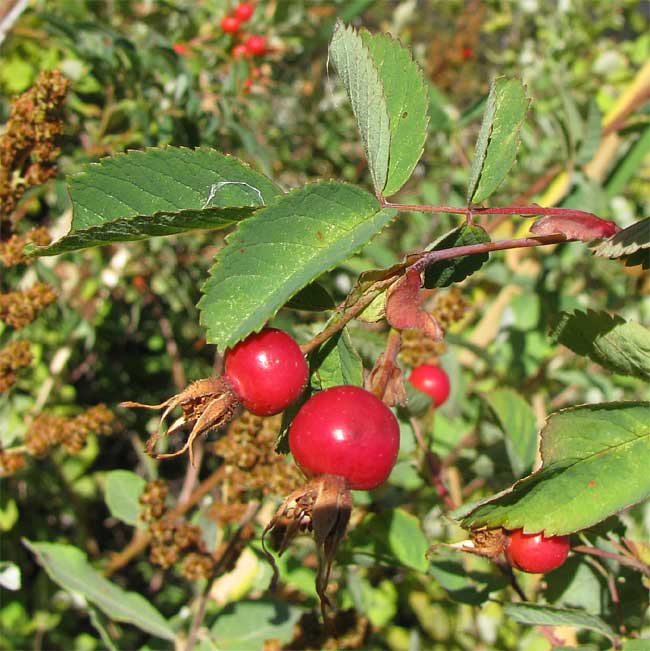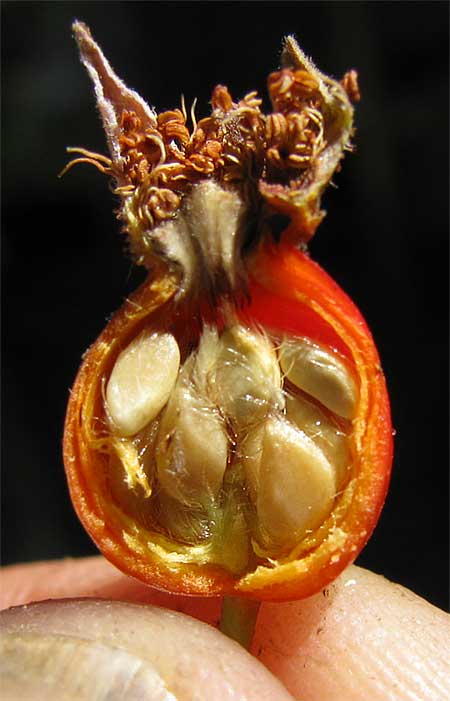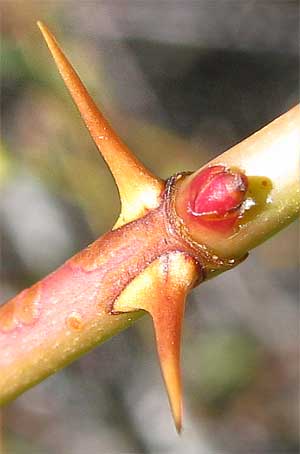Excerpts from Jim Conrad's
Naturalist Newsletter

from the the September 13, 2009 Newsletter, issued from the Siskiyou Mountains west of Grants Pass, Oregon:
WILD ROSES BY THE POND
During much of summer a pretty, small-flowered, red- petaled, thicket-forming wild rose bloomed along the pond as well as many area roadsides and woods edges. Nowadays the flowers have vanished but in their stead shiny, brilliantly red hips have appeared, as shown above.
The hips are small, about 2/5th-inch across (10 mm), with unusually long, slender sepals (calyx lobes). You can see several fruits inside a hip below:

"Fruits inside a hip" is correct, for rose hips are not fruits, and the seedlike things inside them are not seeds.
If you take a flat piece of paper, set numerous flower pistils (a pistil is composed of the female stigma, style and ovary) upright atop its surface, and set many male, pollen-producing stamens around the paper's edges, then bring the paper's corners and sides upward forming a bag with the ovaries inside it and the stamens at the bag's top rim, then you'd have the thing shown in the picture, a rose hip. Technically the hip's red walls are regarded as a hypanthium. The seedlike things within the hip are fruits of the achene type, which means that they are dry, one-seeded fruits that don't split open at maturity, like sunflower seeds.
In the hip picture, notice the brown, crumb-like stamens clustering inside the calyx. Also, the hip is open at the top because the ovaries' styles once extended through that hole so their stigmas could be pollinated.

California's Jepson Manual lists eleven wild-rose species for that state. Around here we have several and three are very similar, all producing small hips with very long, slender-tipped sepals. Maybe the best- known of the three is the California Rose, but that species' prickles are broad-based and usually bent back, catclaw-like. Our species' are straight, as seen at the right. Also, the California's prickles are more or less the same color as the stem, very unlike the two-tone case in the above picture.
The last two species, the Nootka Rose and the Cluster Rose, are very similar and they freely hybridize. I'm calling ours the Nootka Rose, ROSA NUTKANA, because the Nootka's fruiting pedicels seem thicker than those of the Cluster Rose.
In the above picture you can see that a rose hip of this species doesn't offer much to eat. Nancy Turner in Food Plants of British Columbia Indians writes that Native Americans used the hips of Nootka Roses as a food source, preferring them over the Cluster Rose's because they were larger.
Nootka Roses occur from southern Alaska south through western North America to the mountains of western Texas and Californa..